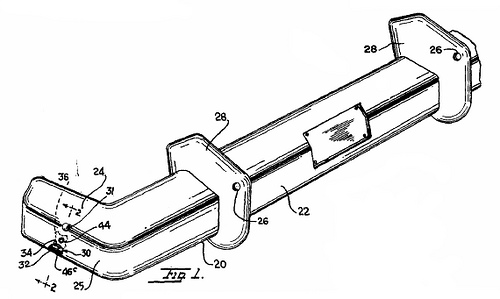
Above: a combination car bumper and bottle opener, patented by Rafael Bonnelly in 1964.
Below: a combination clothes brush and flask, patented by Thomas Helm in 1893.
Maybe you do have a drinking problem.
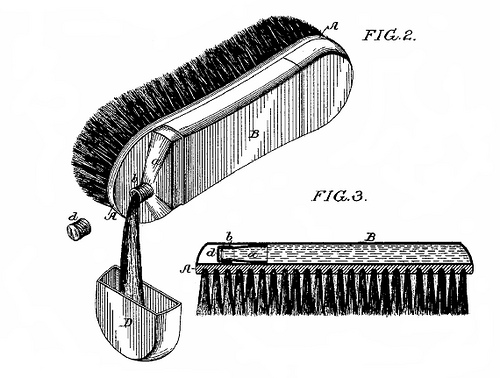

Above: a combination car bumper and bottle opener, patented by Rafael Bonnelly in 1964.
Below: a combination clothes brush and flask, patented by Thomas Helm in 1893.
Maybe you do have a drinking problem.

Dorothy Parker named her Boston terrier Woodrow Wilson “because he was full of shit.”

The Ohio Law Journal thus explains how to draw a deed of gift of an orange:–
‘… If a man would, according to law, give to another an orange, instead of saying, “I give you that orange,” which one would think would be what is called in legal phraseology, “an absolute conveyance of all right and title therein,” the phrase would run thus: “I give you all and singular my estate and interest, right, title and claim, and advantage of and in that orange, with all its rind, skin, juice, pulp and pips, and all right and advantage therein, with full power to bite, cut, suck, and otherwise eat the same, or give the same away, as fully and effectually as I, said A.B., am now entitled to bite, cut, suck, or otherwise eat the same orange, or give the same away with or without its rind, juice, pulp and pips, anything heretofore or hereafter, or in other deed or deeds, instrument or instruments, of what nature or kind soever, to the contrary in any wise notwithstanding.”‘
— Journal of Jurisprudence, April 1885
The digits 1-9 can work some impressive tricks:
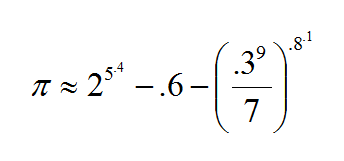
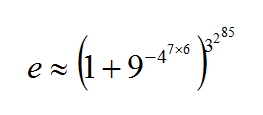
The first formula, found by B. Ziv in 2004, produces the first 10 digits of pi.
The second, astonishingly, reproduces e to 18,457,734,525,360,901,453,873,570 decimal places. It was discovered by Richard Sabey, also in 2004.
(Thanks, Robin.)
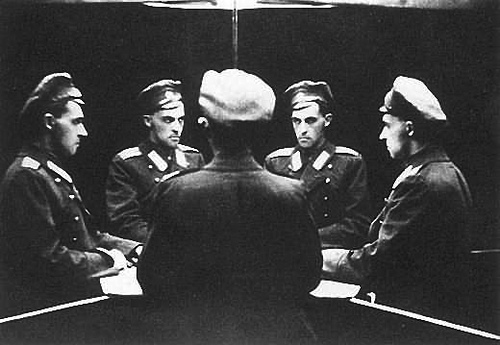
“A man wrote to say that he accepted nothing but Solipsism, and added that he had often wondered it was not a more common philosophy. Now Solipsism simply means that a man believes in his own existence, but not in anybody or anything else. And it never struck this simple sophist, that if his philosophy was true, there obviously were no other philosophers to profess it.”
— G.K. Chesterton, St. Thomas Aquinas, 1933
From a 19th-century British broadside:
Madam,
The love and tenderness I have hitherto expressed to
you is false, and I now feel that my indifference towards
you increases every day, and the more I see you the more
you appear ridiculous in my eyes, and contemptible–
I feel inclined and in every respect disposed and determined
to hate you. Believe me I never had any inclination
to offer you my hand. Our last conversation I assure you
left a tedious and wretched insipidity which has not
possessed me with an exalted opinion of your character,
your inconstant temper would make me miserable,
and if ever we are united, I shall experience nothing but
the hatred of my parents, added to everlasting dis-
pleasure in living with you. I have a true heart to bestow,
but however I do not wish you for a moment to think
it is in your service, as I could not give it to one more
inconstant and capricious than yourself, and one less
capable to do honour to my choice, and my family.
You, Madam, I beg and desire will be persuaded that I
think seriously, and you will do me a great favour to
avoid me. I shall excuse you taking the trouble to
give me an answer to this, as your letters are full of
nonsense and impertinence, and have not a shadow of
wit and good sense. Adieu, and believe me truly, I am
so averse to you, that it is impossible I should ever be,
Madam, your Affectionate Servant and Lover, R.G.
“By reading every other line of the above letter the true meaning will be found out.”
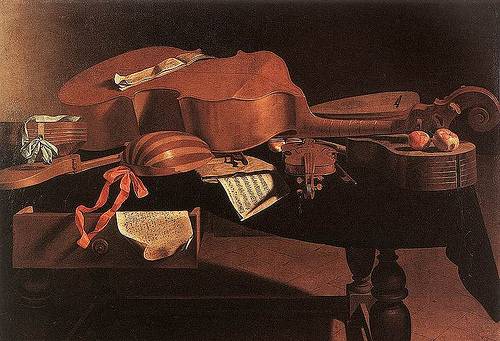
A young man, poorly clothed, presented himself before a dealer in curiosities. ‘Sir,’ said he, showing a violin which he carried, ‘I am a musical artist; this is the season of balls and soirées; I have just had a long illness which has exhausted my purse; my only black coat is in pawn, I shall be much obliged if you will lend me ten francs to redeem it. I will leave as security one of the violins you see, for I have two; it is an excellent instrument. I shall return for it as soon as, thanks to my coat, I shall have earned enough money for the purpose.’ The young man had such an honest bearing that the dealer lent him ten francs and kept the violin, which he hung up in the shop. The next day but one, a gentleman, well-dressed, wearing at his buttonhole the ribbon of the Legion of Honor, was choosing from the dealer’s stock of goods some shell-work. Seeing the violin, he took it up, examining it narrowly. ‘What is the price of that instrument?’ said he. ‘It is not mine,’ replied the shopkeeper; and he related how he came to possess it. ‘This violin,’ continued the unknown, ‘is worth money, it is a Cremona. Perhaps its owner is ignorant of its value. If he returns, offer him two hundred francs for it.’ Then handing fifty francs to the shopman, the unknown said on taking his leave, ‘You will keep that for yourself if the affair succeeds; I will return in a few days.’ Two days after, the young man reappeared, bringing the ten francs to redeem his violin, for which the dealer offered him two hundred. After some hesitation, he agreed. At the end of a week, the dealer, not having seen the decorated gentleman, became suspicious; he carried the violin to an instrument-maker, who offered him three francs for it.
— Thomas Brackett Reed et al., Modern Eloquence, 1900
galericulate
adj. covered by a hat
See whelve.
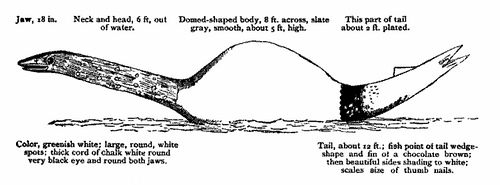
“We have had a visit from a monster turtle fish,” wrote a Miss S. Lovell, rather complacently, to Land and Water in 1891. Lovell was a schoolteacher on Queensland’s Great Sandy Island, and she was quite certain of what she saw:
It let me stand for half an hour within five feet of it. When tired of my looking at it, it put its large neck and head into the water and swept round seaward, raising its huge dome-shaped body about five feet out of the water, and put its twelve feet of fish-like tail over the dry shore, elevating it at an angle. Then, giving its tail a half twist, it shot off like a flash of lightning, and I saw its tail in the air about a quarter of a mile off, where the steamers anchor.
Indeed, when an editor expressed some doubt at this, Miss Lovell took offense: “You speak of the impossible length of its tail. I beg to state this is a most astounding statement from people who have never seen this monster, half fish, half tortoise. The tail was over the dry shore for half an hour, so close to me, that five footsteps would have enabled me to put my hand upon it.”
The editor eventually gave up, but W. Savile-Kent took a fuller account from her and published it in his Great Barrier Reef of Australia two years later; she also gave him a document certifying that seven other people had seen the thing within a few days of her encounter. It hasn’t come back.
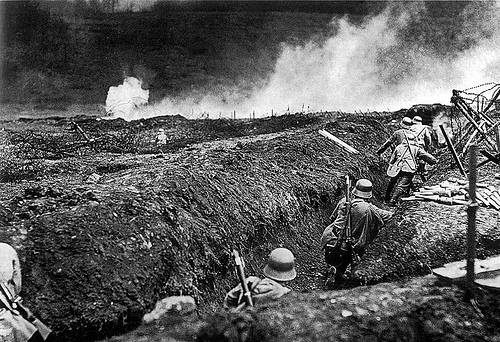
An episode from the German trenches, August 1915, from artilleryman Herbert Sulzbach’s 1935 memoir With the German Guns:
One of the next starlit summer nights, a decent Landwehr chap came up suddenly and said to 2/Lt Reinhardt, ‘Sir, it’s that Frenchie over there singing again so wonderful.’ We stepped out of the dug-out into the trench, and quite incredibly, there was a marvellous tenor voice ringing out through the night with an aria from Rigoletto. The whole company were standing in the trench listening to the ‘enemy,’ and when he had finished, applauding so loud that the good Frenchman must certainly have heard it and is sure to have been moved by it in some way or other as much as we were by his wonderful singing.
“Musical compositions, it should be remembered, do not inhabit certain countries, certain museums, like paintings and statues,” wrote Henri Rabaud. “The Mozart Quintet is not shut up in Salzburg: I have it in my pocket.”